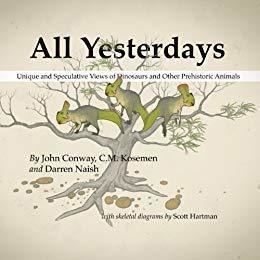8.6 /10 1 Votes
| 4.3/5 Goodreads | |||||||||||||||||||||||||||||||||
 | ||||||||||||||||||||||||||||||||||
Similar The Future Is Wild, Man After Man, All Tomorrows | ||||||||||||||||||||||||||||||||||
All yesterdays book launch talk darren naish
All Yesterdays is an art book regarding the reconstruction of dinosaurs and other extinct animals by John Conway and C.M. Kosemen. It was published in 2012.
Contents
Overview
The book first recounts the history of changing perceptions of dinosaurs as expressed in artwork. It begins with the sluggish and slow dinosaurs seen in the works of Charles R. Knight, and then continues into analyzing reconstructions after the Dinosaur renaissance. It points out that these reconstructions do not take the often bizarre integumentary coverings of living animals into account, and that dinosaurs should be portrayed as natural animals that aren't 'shrink-wrapped' with many of the individual bones visible.
The remainder of the book consists of pictures with accompanying explanatory texts. Each picture displays a hypothetical adaptation that an extinct animal could have possessed, such as a plesiosaur disguised on the seafloor like a decorator crab or something that dinosaurs aren't usually shown doing, such as a sleeping Tyrannosaurus. The texts describe the adaptations or habits and explain why they are plausible. Some of the entries are deliberately made to break a paleoartistic cliché, such as a Tenontosaurus walking alone without a predatory Deinonychus in sight (Tenontosaurus is almost exclusively depicted in dinosaur art as the prey of Deinonychus).
The second and last major section of the book is titled "All Todays", and depicts animals from the present day as if extraterrestrial paleontologists from the future were reconstructing them from fossilized skeletons. Some of the creatures are somewhat recognizable, like a vulture depicted with pterosaur-like wings; others are completely unrecognizable, like a rhinoceros reconstructed with no nose horn and a sail instead of a hump. By showing how completely extant animals might be misunderstood if known only from skeletal remains, All Yesterdays shows that our own conceptions of extinct animals are likely equally mistaken.
Reception
All Yesterdays has received mostly very enthusiastic reviews from palaeontologists, and is perceived as introducing or popularising a new "third wave" approach to palaeoart after the classical period of Knight, Zallinger, Burian and others, and the more modern work of Bakker, Paul, Henderson and others. For example, John Hutchinson of the Royal Veterinary College wrote "This is a thinking person’s book ... for rumination, to challenge your preconceptions, not to have a flashy coffee table book. It’s not eye candy — it’s more like brain jerky." And Mike Taylor wrote "All Yesterdays is not only the most beautiful but also the most important palaeoart book of the last four decades".
